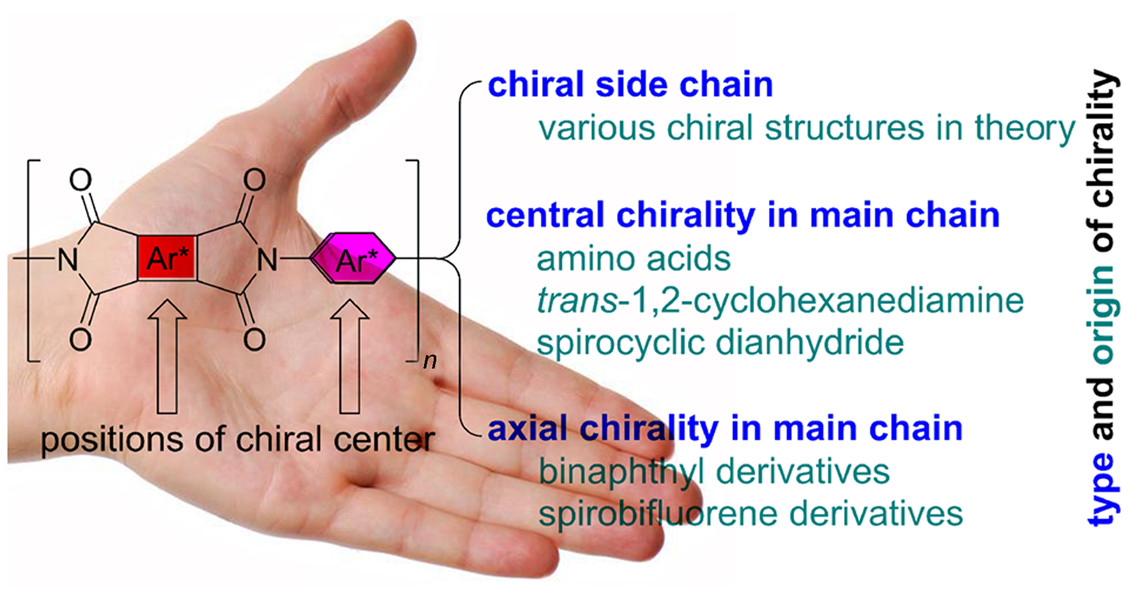• 综述与评论 •
康传清, 闫吉军, 高连勋. 手性聚酰亚胺的合成、结构与性能[J]. 化学进展, 2015, 27(1): 59-69.
Kang Chuanqing, Yan Jijun, Gao Lianxun. Synthesis, Structure and Properties of Chiral Polyimides[J]. Progress in Chemistry, 2015, 27(1): 59-69.

手性聚酰亚胺逐渐成为手性高分子研究的一个重要方面,在分子识别、对映体选择性分离、不对称催化等领域有潜在的应用,日益受到研究者的重视。本文综述了近二十年手性聚酰亚胺的研究进展,将手性聚酰亚胺按照手性结构的引入方式分为侧链手性、主链中心手性和主链轴手性三种类型,并分别加以总结和阐述,介绍了具有代表性的光活性聚酰亚胺的结构、合成和性能,特别关注了手性聚酰亚胺的高次结构的形成以及与其手性光活性相关的性能与应用。最后,本文阐述了手性聚酰亚胺研究面对的挑战与未来发展前景,探索手性聚酰亚胺的合成、性质和应用,建立合理的模型和分析手段,深入探讨手性聚酰亚胺的高次结构仍然是值得深入研究的重点方向。
中图分类号:
分享此文:
| [1] Ho R M, Chiang Y W, Lin S C, Chen C K. Prog. Polym. Sci., 2011, 36: 376. |
| [1] | 韩冬雪, 金雪, 苗碗根, 焦体峰, 段鹏飞. 超分子组装体激发态手性的响应性[J]. 化学进展, 2022, 34(6): 1252-1262. |
| [2] | 周明浩, 姜爽, 张天永, 史永宏, 金雪, 段鹏飞. 手性钙钛矿纳米材料的构筑及光电性能[J]. 化学进展, 2020, 32(4): 361-370. |
| [3] | 俞杰, 龚流柱. 手性氨基酸酰胺催化剂的发现及研究进展[J]. 化学进展, 2020, 32(11): 1729-1744. |
| [4] | 王童, 文姣, 李良春, 郑仁林, 孙德群. 脱氢氨基酸的合成及其在药物研发中的应用[J]. 化学进展, 2020, 32(1): 55-71. |
| [5] | 张春秋, 罗全, 刘俊秋, 沈家骢. 蛋白质功能化新策略:嵌入非天然氨基酸[J]. 化学进展, 2012, 24(04): 577-588. |
| [6] | 曲颖, 李玉锋, 陈春英. 同步辐射及相关核分析技术在纳米材料生物效应研究中的应用[J]. 化学进展, 2011, 23(7): 1534-1546. |
| [7] | 胡素琴, 张晓东, 许敏, 孙立. 离子液体在生物质利用方面的应用[J]. 化学进展, 2011, 23(4): 731-738. |
| [8] | 安众福 陈润锋 史慧芳 马琮 石乃恩 黄维. 联萘酚衍生物的光电功能及其应用*[J]. 化学进展, 2010, 22(10): 1973-1982. |
| [9] | 鞠思婷 朴玲钰 杨磊 刘祥志 张天慧 李忠军. 碳纳米管与生物分子的相互作用*[J]. 化学进展, 2010, 22(09): 1767-1775. |
| [10] | 耿杰,于海佳,张海元,徐海霞,曲晓刚. 稀土氨基酸配合物与核酸的相互作用*[J]. 化学进展, 2009, 21(05): 866-872. |
| [11] | 田善喜. 氨基酸分子构象稳定性与光电离解离动力学的氢键效应*[J]. 化学进展, 2009, 21(04): 600-605. |
| [12] | 孙霞,刘庆平,郑学仿. 荧光和圆二色谱法用于低密度脂蛋白氧化的研究[J]. 化学进展, 2008, 20(11): 1761-1767. |
| [13] | 方晓明,张正国,陈清林. 具可见光活性的氮掺杂二氧化钛光催化剂*[J]. 化学进展, 2007, 19(9): 1282-1290. |
| [14] | 高强,徐耀,吴东,孙予罕. 氨基酸在固体表面的吸附*[J]. 化学进展, 2007, 19(06): 1016-1025. |
| [15] | 高勇军,马晶军,吴秋华,臧晓欢,王春. 手性联萘酚配合物催化的缺电子烯烃不对称环氧化反应*[J]. 化学进展, 2007, 19(05): 796-804. |
| 阅读次数 | ||||||
|
全文 |
|
|||||
|
摘要 |
|
|||||